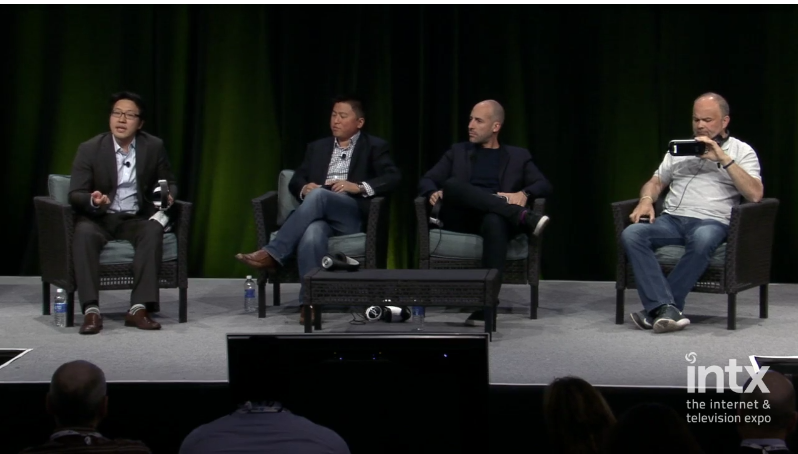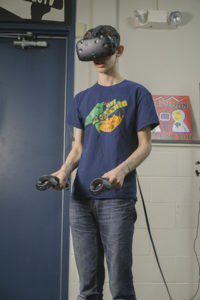The presentation begins with the group entering virtual reality themselves and introducing the topic of their conversation. First they talk about the public’s perception of VR. Most people believe that virtual reality is here to stay, now that more are aware of it. The speakers encourage anyone who is interested in experiencing virtual reality to try it out now, because there are a lot of conventions where companies are letting anyone use their products. According to a survey, across all age groups more than 50% are most excited about watching movies and television in VR. From there, three of the panelists talk about their specialty within the industry.
Edward Tang, the co-founder and Chief Strategy Officer of the company Avegant, talks about the devices used in VR. His company has produced a device that doesn’t use a screen at all, and instead projects the virtual image into the eyes. This is said to reduce retinal train. The image is projected onto many microscopic mirrors in front of the viewers eyes. This means there is no pixelation, and the image looks more lifelike because we are seeing light reflected off of surfaces, just like we observe the real world. The device is completely mobile, and can be transformed from a normal pair of headphones into an audio/visual virtual reality device with the touch of a button.
[su_box title=”Summary” style=”soft”]
- Most people believe that virtual reality is here to stay, now that more are aware of it.
- Anyone who is interested in experiencing virtual reality should try it out now, because there are a lot of conventions where companies are letting anyone use their products.
- One company, Avegant, has produced a device that doesn’t use a screen at all, and instead projects the virtual image into the eyes. This is said to reduce retinal train. The image is projected onto many microscopic mirrors in front of the viewers eyes.
- Vrtify is a company that is exploring another promising application for VR: music, specifically letting people experience concerts virtually. If a concert isn’t sold out, instead of letting the extra tickets go to waste, extras can be sold to VR users who want to watch a live show from the comfort of their home.
- VTime is the world’s first social virtual reality experience. It allows people to have up to four-person conversations with people around the world in a variety of virtual locations. It also lets people experience a virtual theater or television in a virtual room, so you can watch movies with friends and family as if they are there with you.
- No matter how detailed a presentation is, you need to experience VR to fully understand its appeal.
- Every speaker agrees that, while necessary to keep the industry alive, advertising needs to be integrated into virtual reality in a non-disruptive way in order for it to be effective.
- Their parting advice is to attend Imagine Park, a convention where people can use all of the technology discussed in the talk. [/su_box]
The next speaker is Facundo Diaz, the founder and CEO of Vrtify, brings up another promising application for VR is music, specifically letting people experience concerts virtually. Diaz tells us that virtual reality is the newest evolution in music technology, after the walkman and ipod. Vrtify is using the same business model for their platform, which will allow users to both listen to and live music. He also brings up that if a concert isn’t sold out, instead of letting the extra tickets go to waste, extras can be sold to VR users who want to watch a live show from the comfort of their home.
Julian Price, the CMO of VTime, discusses the applications of social VR. VTime is the world’s first social virtual reality experience. It allows people to have up to four-person conversations with people around the world in a variety of virtual locations. It also lets people experience a virtual theater or television in a virtual room, so you can watch movies with friends and family as if they are there with you. Julian is interested in the possibilities of being connected to others with this new technology in real time.
Lastly, the group discusses the way the public can and will interact with this new technology. They make it clear that no matter how detailed their presentation was, you need to experience VR to fully understand its appeal. Every speaker agrees that, while necessary to keep the industry alive, advertising needs to be integrated into virtual reality in a non-disruptive way in order for it to be effective. Their parting advice is to attend Imagine Park, a convention where people can use all of the technology discussed in the talk.



